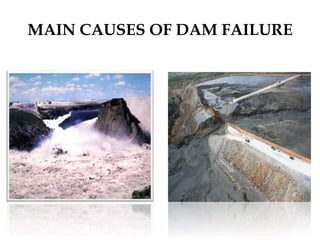Dam presentation
- 2. PRESENTATION TOPIC: DAMS PRESENTED TO: SIR DAWOOD-UL-HASSAN PRESENTED BY: ABDUL MUTAKABER BSCT01133006
- 3. Dams Definition: Dam is a solid barrier constructed at a suitable location across a river valley to store flowing water. Storage of water is utilized for following objectives: • Hydropower • Irrigation • Water for domestic consumption • Drought and flood control • For navigational facilities • Other additional utilization is to develop fisheries
- 4. TYPES OF DAMS 1. GRAVITY DAMS: • These dams are heavy and massive wall-like structures of concrete in which the whole weight acts vertically downwards. • Bhakra Dam is the highest Concrete Gravity dam in Asia and Second Highest in the world. • In a gravity dam, the force that holds the dam in place against the push from the water is Earth’s gravity pulling down on the weight of the dam itself. • In a gravity dam, stability is secured by making it of such a size and shape that it will resist overturning, sliding and crushing at the toe.
- 5. TYPES OF DAMS 2. ARCH DAMS: • An arch dam is a type of dam that is curved and commonly built with concrete. • The arch dam is a structure that is designed to curve upstream so that the force of the water against it, known as hydrostatic pressure. • An arch dam is most suitable for narrow gorges or canyons with steep walls of stable rock to support the structure and stresses.
- 6. TYPES OF DAMS 3. EARTH DAMS: • An embankment dam is a massive artificial water barrier. They are mainly built with clay, sand and gravel, hence they are also known as Earth fill dam or Rock fill dam. • They are trapezoidal in shape. • Earth dams are constructed where the foundation or the underlying material or rocks are weak to support the masonry dam or where the suitable competent rocks are at greater depth. • Earthen dams are relatively smaller in height and broad at the base. DISADVANTAGE: • Water can easily pass through it. • less durable than other type dams. • The height of this dam is less.
- 7. SELECTION OF SITES 1. Topographically: • Place must be suitable. • Narrow gorge or small valley with enough catchment areas. 2. Technically: • Should be strong, impermeable, and stable. • Strong rocks leads to better designs. • impermeable sites ensures better storage • Stability with reference seismic shocks and slope failures around the dam are a great relief to the public as well as the engineering. 3. Constructionally: • Should be not far off from deposits of materials which would be useful for construction • Natural materials of construction Like earth, sand, gravel, and rock should be easily feasible otherwise cost will increase.
- 8. SELECTION OF SITES 4. Economically: • Benefits arising should be realistic and justified in terms of land irrigated or power generated or floods averted or water stored. 5. Environmentally: • The site of the dam should not involve ecological disorder (in the life of plants, animals and man). • The fishes in the streams are also affected, so things should also be considered. • The dam and the associated reservoir should become an acceptable element of the ecological set up of the area.
- 9. FORCES ACTING ON A DAM 1. Weight Of The Dam: • In gravity dams and embankment dam the weight of the dam is the major force acting for holding the water back on the upstream side. • The forces arising due to the weight of the dam are compressive in nature. 2. Water Pressure: • The dam is required to resist horizontal forces acting due to weight of the water impounded on it. • This water pressure can be calculated by hydrostatic pressure distribution. 3. Earthquake Forces: • The disturbance in dams is highly dangerous because they store huge volumes of water. • Dams built in the areas known to be seismically active must be designed to withstand additional forces that are likely to arise in a future shock.
- 10. FORCES ACTING ON A DAM 4. Uplift Pressure : • It is almost impossible to make a dam impervious structure. • Many minute cracks and pores are left in the dam and the foundation body. • Water is likely to find its way into these minute openings through seepage and gradually fill them up. • It exerts an upward pressure on the body of the dam.
- 11. MAIN CAUSES OF DAM FAILURE Common causes of dam failure include: • Sub-standard construction materials/techniques. • Spillway design error. • Geological instability caused by changes to water levels during filling or poor surveying. • Sliding of a mountain into the reservoir. • Poor maintenance, especially of outlet pipes. • Extreme inflow. • Human, computer or design error. • Internal erosion, especially in earthen dams.
- 12. MAIN CAUSES OF DAM FAILURE
- 13. CONCLUSION Generally there are mainly the three types of dam which are selected on the basis of need of water requirement and our basic need such as :- • Hydropower • Irrigation • Water for domestic consumption • Drought and flood control • For navigational facilities • Other additional utilization is to develop fisheries • Due to some of the carelessness while the construction it hampers the life and strength so it is necessary to study the basic concept of the dams. • Utilization of dam water also promotes the production of the hydroelectricity.














